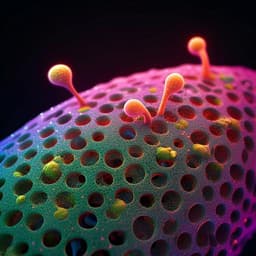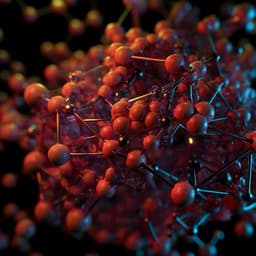
Physics
Spin-wave-driven tornado-like dynamics of three-dimensional topological magnetic textures
L. Qiu, L. Shen, et al.
This groundbreaking research by Lei Qiu, Laichuan Shen, and Ka Shen uncovers tornado-like dynamics in skyrmion tubes and chiral bobbers through micromagnetic simulations, promising a novel method to differentiate between these intriguing magnetic structures based on their unique motion characteristics.
~3 min • Beginner • English
Introduction
Topological magnetic textures (skyrmions, vortices, merons, etc.) exhibit rich physics and promise for spintronic devices. Material parameters and environments strongly affect their formation and morphology (e.g., isolated vs lattice skyrmions). Recent advances extended from 2D to 3D textures (hopfions, torons, chiral bobbers) with intriguing dynamics. In thick films with bulk Dzyaloshinskii–Moriya interaction (DMI), skyrmion tubes (SkTs) and chiral bobbers (ChBs)—SkTs terminating at Bloch points (BPs)—can be stabilized simultaneously and are robust, but difficult to distinguish with conventional surface-sensitive imaging. Although current-driven manipulation of 3D textures has been demonstrated, it requires high current densities that cause heating and can destabilize SkT/ChB. Spin-wave-driven dynamics offer low-power control and applicability in insulators, but remain largely unexplored for 3D textures. This study investigates, via micromagnetic simulations, how spin waves drive SkT and ChB dynamics, how the dynamics differ between them, and how spin waves are scattered by these 3D textures.
Literature Review
Prior work established the formation and control of various 2D and 3D topological textures, including skyrmions and their variants (skyrmion bags, high-order skyrmions) and 3D textures (hopfions, torons, ChBs). Stabilization of SkTs and ChBs in thick films via bulk DMI has been demonstrated both theoretically and experimentally, with BPs imparting distinctive dynamical signatures. Electrical control using spin-transfer or spin–orbit torques has been reported for 3D textures but typically requires large current densities with detrimental heating. Spin-wave interactions with 2D skyrmions have been studied, revealing chiral scattering and propulsion, but analogous studies in 3D—especially involving ChBs and BPs—are scarce. Analytical predictions for BP scattering suggested Rutherford-like symmetry for isolated BPs, a hypothesis revisited here under realistic coupling to neighboring skyrmions.
Methodology
Micromagnetic simulations solve the Landau–Lifshitz–Gilbert equation dm/dt = −γ m × B_eff + α m × dm/dt with B_eff = −δW/δM. The energy density includes exchange A, perpendicular anisotropy K1, Zeeman with external field H_ex, bulk DMI D, and demagnetization field. Film size is 300 × 300 × 41 nm³ with 1 × 1 × 1 nm³ discretization. Parameters: A = 0.1 pJ m⁻¹, K1 = 5 kJ m⁻³, M_s = 100 kA m⁻¹, D = 0.05 mJ m⁻², Gilbert damping α = 0.001 (α = 0.01 used in specific tests of damping effects). A perpendicular external field μ0H_ex ≈ 0.18 T is used unless stated. Initial states: (i) bobber-shaped reversed-magnetization region of given length and radius (relaxation leads to SkT, ChB, or uniform FM depending on parameters), enabling control of ChB penetration length L_B; (ii) initial SkT configuration leading to stable SkT under the same H_ex. Spin waves are generated by an AC magnetic field h_rf(t) = h_rf sin(2π f t) x̂ at f = 120 GHz (also tested at 60 GHz) applied in a thin excitation plane (two-unit-cell width) producing waves propagating along +x. Absorbing boundary conditions (gradually enhanced damping) are used laterally to suppress reflections; free boundary at top and bottom surfaces. Dynamics are quantified by layer-resolved in-plane topological centers R(z, t) computed from the topological density p = m · (∂_x m × ∂_y m), enabling tracking of lateral motion, rotations, and Hall angles. Additional analyses include derivation of spin-wave dispersion in bulk with DMI showing k-space shift and resultant group-velocity components in x and z; interference from surface reflections leads to thickness-dependent intensity modulation ~1 + cos(2 z k0z) with period ~π/k0z ≈ 12.6 nm (k0z ≈ 0.25 nm⁻¹). Interlayer exchange A_⊥ is varied to probe its role in lateral rotation; force-balance models incorporating Magnus and interlayer attractive forces are developed to explain dissipative rotations and deformation profiles. Velocity–field characteristics are obtained by measuring steady-state velocities versus h_rf, and threshold fields for ChB motion are extracted for various L_B and H_ex.
Key Findings
- Tornado-like dynamics: Under spin-wave drive, both SkT and ChB exhibit lateral rotations of layer-resolved topological centers while translating. For SkT, the rotation centers across thickness form a distorted y–z profile that grows with excitation strength; for ChB, rotation centers show only slight tilt along thickness. The BP of ChB remains essentially stationary for weak drives, serving as a pinning center.
- SkT motion and Hall angle: SkT collectively moves toward the spin-wave source with a finite Hall angle θ_H ≈ 13.5°. Layer-resolved trajectories show nearly circular relative rotations with larger radii near surfaces and an approximate π phase difference between upper and lower halves of the film.
- ChB internal motion: In ChB, skyrmion centers rotate relative to the BP with larger rotation radii closer to surfaces; the BP itself is pinned for weak drives, preventing net translation.
- Origin of deformation: Bulk DMI shifts isofrequency contours in k-space, imparting both x and z components to group velocity. Surface reflection creates interference and a thickness-dependent intensity modulation ~1 + cos(2 z k0z) with period ≈ 12.6 nm, matching the observed distortion of rotation centers in y–z.
- Force balance mechanism: In regions of weak spin-wave intensity (thickness nodes), small drive and damping imply Magnus force of moving SkT is balanced by interlayer dragging forces, producing the observed y-direction lag/lead among layers and the distorted profile. For ChB, the lack of net motion suppresses Magnus force; drive is chiefly balanced by BP pinning, yielding a simpler y–z profile.
- Dissipative nature of rotations: Increasing damping (α = 0.01) causes rotation radii to decay over time, indicating dissipative (not persistent) rotations. The number of oscillation periods depends strongly on out-of-plane exchange A_⊥, weakly on h_rf.
- Rotation frequency scaling: A force-balance model with interlayer attractive force F_a ∝ A_⊥ and Magnus force predicts rotational frequency f_rot ∝ A_⊥. Simulations confirm linear dependence of rotation frequency on A_⊥.
- Velocity–drive relation: SkT velocity scales with driving power, well-fitted by v_SkT ∝ h_rf². ChB exhibits a threshold in h_rf; below threshold, ChB is immobile, above threshold it translates while maintaining internal rotations about the BP. The threshold field depends linearly on ChB penetration length L_B; longer ChBs require smaller h_rf to depin. External field H_ex has only a marginal effect on the threshold. Excessively strong driving destabilizes both ChB and SkT. The maximal SkT velocity is expected to be limited to ~100 m s⁻¹ as in 2D spin-wave-driven skyrmions.
- Spin-wave scattering: 3D scattering patterns from SkT and ChB show visible interference on both sides of the textures, contrasting with the strongly asymmetric 2D case. Scattering is layer-dependent due to thickness-modulated intensity. Near the BP, scattering is asymmetric, deviating from Rutherford-like patterns predicted for isolated BPs, reflecting coupling to neighboring skyrmions.
Discussion
The study addresses how spin waves drive 3D topological textures and how their responses differ. SkTs translate with a Hall angle and display thickness-dependent internal rotations, with velocity scaling quadratically with drive amplitude, consistent with spin-wave momentum transfer. ChBs, in contrast, are pinned by the Bloch point and require surpassing a critical drive to move; the linear dependence of the depinning threshold on penetration length provides a practical criterion to distinguish ChBs from SkTs and to estimate L_B experimentally. The observed tornado-like dynamics and distorted y–z profiles are traced to DMI-induced oblique propagation and interference of spin waves across thickness, producing spatially modulated driving forces that, via interlayer coupling and Magnus forces, set the layer-dependent motions. The dissipative character of rotations and their dependence on interlayer exchange underscore the role of interlayer coupling in 3D skyrmion-string dynamics. The scattering results highlight fundamental differences from 2D cases and from idealized Rutherford-like BP scattering, emphasizing the importance of 3D coupling and layer-dependent spin-wave fields. These insights are relevant for designing low-power magnonic control schemes and for experimental identification and manipulation of 3D textures.
Conclusion
Micromagnetic simulations reveal that spin waves drive distinctive tornado-like dynamics in 3D skyrmion tubes and chiral bobbers. Bulk DMI induces thickness-varying spin-wave intensities, which, together with interlayer coupling and Magnus forces, produce lateral rotations and distorted rotation-center profiles. SkT motion shows no threshold and velocity scaling with h_rf², whereas ChB exhibits a finite depinning threshold that decreases linearly with penetration length, offering an experimental route to distinguish ChBs from SkTs and to estimate L_B. Spin-wave scattering by SkT/ChB differs from 2D cases and from symmetric Rutherford-like BP scattering due to 3D coupling. These behaviors suggest pathways for low-power magnonic control and spintronic applications using 3D topological textures. Future work could systematically map maximal attainable velocities, incorporate temperature and disorder, and explore frequency- and geometry-dependent control to optimize device performance.
Limitations
The results are based on micromagnetic simulations with specific material parameters, film thickness, and discretization, which mimics crystal-field pinning and may influence depinning thresholds and stability. Thermal fluctuations, defects, and real microstructural disorder are not explicitly modeled. Most analyses focus on a single excitation frequency (120 GHz) with limited frequency variation; broader frequency and geometry sweeps could refine generality. Very strong drives lead to texture instability, limiting accessible regimes; the maximal SkT velocity is not quantitatively established and requires systematic studies. Analytical treatment of 3D scattering in the presence of neighboring skyrmions and BPs is not fully developed.
Related Publications
Explore these studies to deepen your understanding of the subject.







